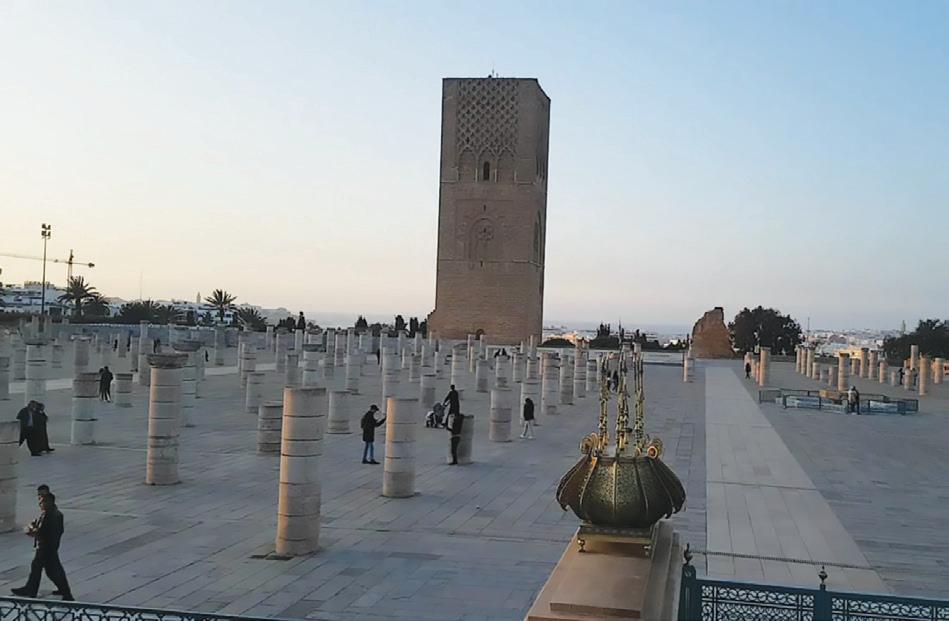
12 minute read
Lost in Gwangju: Gwangju’s Highway to
▲ A retro road sign along Gwangju’s highway to nowhere.

Advertisement
Gwangju’s Highway to Nowhere Links Testaments of 5.18
Written and photographed by Isaiah Winters
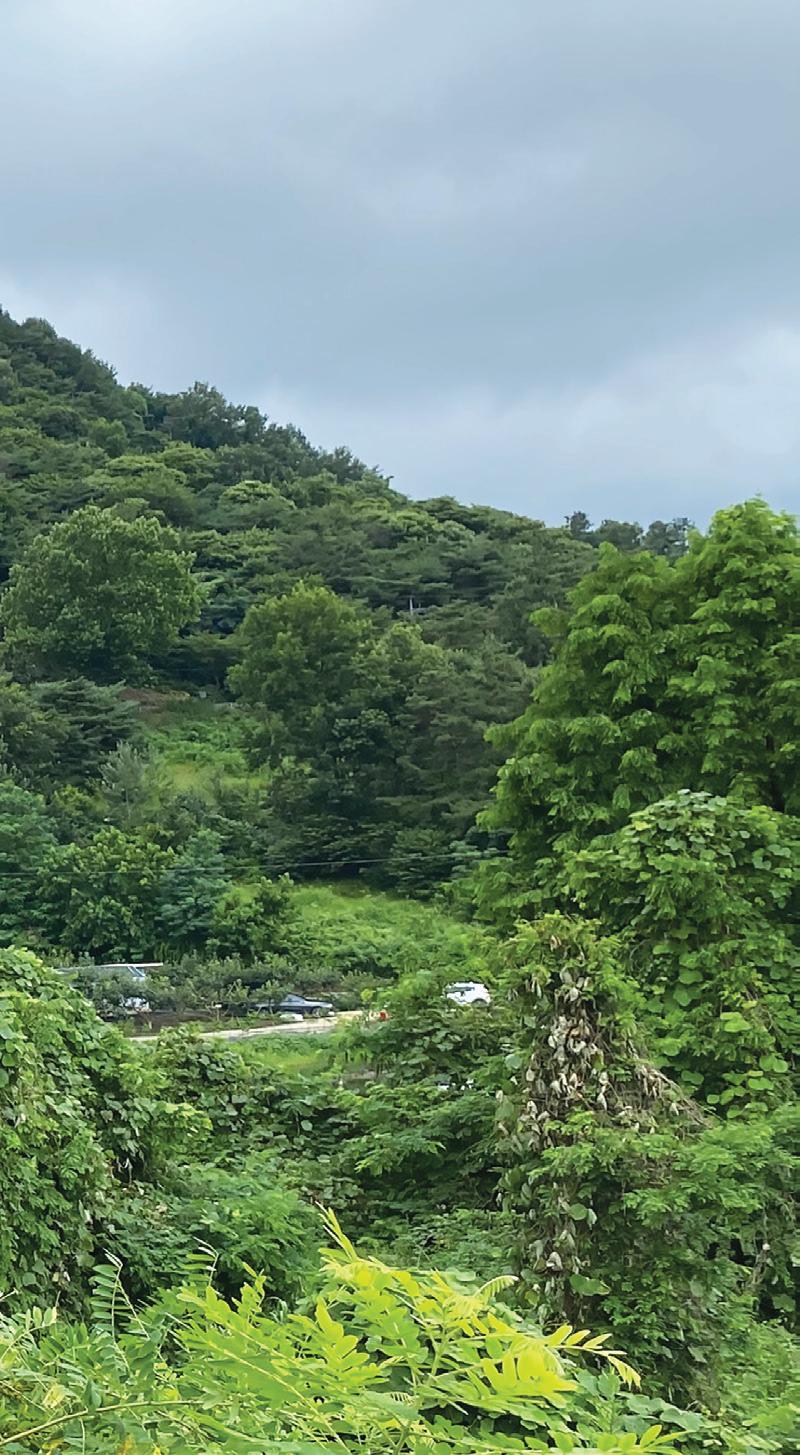
Impromptu road trips are among my favorite things to do in Korea, and the Honam region rarely disappoints. If only I had the time, it’d be a cinch to produce an additional “Lost in Honam” column every month, as this region is largely overlooked and thus laden with lowhanging fruit. This month’s article will be a sort of Lost in GwangjuHonam hybrid, as I’ve finally made time to visit a provincial haunt linked to 5.18’s more metropolitan flashpoints: Gwangju’s highway to nowhere.
I first noticed this highway long ago while on the way to Jangseong from Gwangju but never bothered to check it out until my wife began learning to drive. Finding wideopen spaces for driving practice isn’t always easy in Gwangju, so thinking
▼ Security drives off unaware while I snipe photos from the overpass. it might be a good place for her to get some experience behind the wheel, I decided to head northbound on Highway 25 to see if it was somehow accessible. To my surprise, it was indeed accessible, with no warning signs prohibiting entry – well, sort of.
I first walked the empty highway on foot, which was an uncanny experience suggestive of how our world might look post-humanity. The only road sign I encountered was crooked, sun-warped, and written in an older font reminiscent of the 1980s. Adding to the highway’s eeriness, the sign was also terribly inaccurate, saying Gwangju was 30 kilometers away when City Hall was in fact only 15 kilometers away – and in the opposite direction. It was around this time that I spotted a

security car parked on the shoulder ahead, which was my de facto “sign” that visitors might not be welcome.
It turns out that the flawed and timeworn road sign I’d seen was actually only about three years old, and its retro font and hanja characters were deliberately designed that way to evoke the look and feel of the past. The reason for such meticulous attention to detail, of course, was to provide a backdrop for the highway scenes in the 2017 film A Taxi Driver. As part of the old Honam Expressway, this abandoned tract of highway was perfect for reproducing the provincial military blockade of Gwangju during 5.18, doubly so as there’s a real military base nearby that likely provided some of the armored vehicles featured in that part of the film.
The prop sign, which now sits tilted and sun-cracked among ever rising foliage, obviously wasn’t built to last. In a few more years, its message will likely peel off, by which time the bushes will have swallowed it whole. A minor mystery remains as to how it became tilted in just three years.
Some of the more parsimonious explanations are simple root heave, attempted theft, or shoddy construction. Anyway, it’s interesting that the filmmakers would leave it there, almost as a memorial to the film and the rural highway’s significance during the military crackdown of May 1980. Today this stretch of snow-prone highway has been made redundant by the safer Motjae Tunnel connecting Jangseong and Gwangju. What will become of the old pass is anyone’s guess.
Another piece of 5.18 history featured in A Taxi Driver – and one with a more certain future – is the old Red Cross Hospital downtown. Later renamed Seonam University Hospital, it was the place where certain hospital scenes were shot, and much like the faux-retro road sign, the hospital’s new back gate is another one of the film’s tangible imprints on Honam. Although the hospital was already the centerpiece of a Lost in Gwangju article twenty issues ago (see issue #203), in light of recent changes in its ownership, it seems apropos to include an update in this article.
In a substantial victory over private sector bidders, the old Red Cross Hospital was officially acquired by Gwangju City at the end of July for the sum of 8.85 billion won. Before the recent purchase was finalized, there had been serious fears among those seeking to preserve the hospital that the liquidators of Seonam University would sell the property to a private bidder, which would’ve put the hospital’s future in far greater jeopardy 1 .
The recent public acquisition, however, suggests a brighter future for the historical site, which closed in 2014 due to mismanagement and has since been home to squatters.
To be fair, whoever has been squatting there seems to be looking after the place, which is largely free of vandalism. On my most recent visit, the only changes I noticed were that the abandoned ambulance out back had been removed and a few new rooms had been made accessible, including the maternity ward, x-ray room, and records room.
Otherwise, the place is more or less being respectfully maintained by its unauthorized residents. That they’ll soon be left homeless following the building’s preservation is a rather cheerless inevitability.

There are a few other urban sites linked to 5.18 that are similarly inching towards better preservation. These include the former 505 Security Forces’ headquarters, which will be turned into a historical park starting next year, and the former Armed Forces Gwangju Hospital, which has already been converted into a historical park and is currently receiving additional safety checks 1 .
As these two sites were the subject of my very first Lost in Gwangju article thirty issues ago (issue #193), I’m chuffed to see progress in their preservation. Usually, urban exploring teaches me to get used to disappointing losses of history. Thankfully, there are exceptions.
Source
1 Gu, G. (2020, August 5). 505보안부대 옛터 등 5·18사적지 4곳 보존사업 어떻게 . Newsis. https://newsis.com/view/ ?id=NISX20200805_0001119792

The Author
O r i g i n a l l y from Southern California, Isaiah Winters is a Gwangju-based urban explorer who enjoys writing about the City of Light’s lesser-known quarters. When he’s not roaming the streets and writing about his experiences, he’s usually working or fulfi lling his duties as the Gwangju News’ heavily caff einated chief proofreader.
▲ A view of the maternity ward inside the old Red Cross Hospital.
▼ Outdated x-ray equipment sits in complete darkness inside the old Red Cross Hospital.

The Dreamland:


Chefchaouen
Morocco
Written and photographed by Rida Farah
Morocco is a country of beauty with a unique landscape. Taking advantage of its northern position on the African continent and its accessibility to the Mediterranean region – in addition to being a part of the Arab world – Morocco has become a host country for Arab and foreign tourists alike. Th e best months for tourism in Morocco extend from March to May, as this period is characterized by moderate and beautiful weather with occasional light rainfall. Here are some cities worth visiting on your future trip.
Rabat
Rabat is the Moroccan capital and second largest city in the country. It is located on a large plain near the Atlantic Ocean, and in the middle of it fl ows the Abi Raqraq River. Most of Morocco’s tourist attractions are concentrated in Rabat’s city center, the most important being Hassan II, the Kasbah des Oudayas, and the historic city of Challah. B.C. It is one of the most important archaeological sites and famous tourist areas in Rabat. Challah’s main archaeological site includes a large courtyard and ancient baths in addition to the main temple.
Th e Hassan Tower is one of the most famous historical monuments located in the heart of Rabat, with a history spanning nine centuries. Th e site is surrounded by a large number of symbolic mausoleums, such as those of King Mohammed V and King Hassan II.
Th e Mausoleum of Mohammed V is located next to the famous Hassan Tower in Rabat and includes tombs of the Moroccan monarch and his two sons, King Hassan II and Prince Abdallah.
Th e building is a wonderful masterpiece of modern architecture, characterized by its green tiled roof and white walls. Mohammed V’s tomb was built in 1971 and is considered one of the most important features of the Moroccan capital.
Marrakech
Jamaa El-Fna Square dates back to the founding of Marrakech, where it was built during the time of the Almoravid state in the 15th century. Yet, its importance only increased after the construction of the Koutoubia Mosque nearly a century later, with this square as the hub of shopping at that time. Kings used it as a large courtyard to show off their armies and learn about their forces’ preparations before launching battles. Now, it is considered one of the most important tourist spots in Marrakech and a symbol of the city, which prides itself on its vitality and appeal to Arab and foreign tourists.
You can see interesting snake-charming shows and stroll through the courtyard for a folk tour, as it is considered the meeting point between the city, the warehouse, and El-Mellah. You can also see performances by storytellers and musicians, including those that feature a rich and unique heritage. There are acrobats, dancers, animal exhibitors, and henna placards, as well as memorabilia from various distinctive heritage industries. Do not miss this square with its romantic and fun nightlife.
The Majorelle Garden is located in the Medina of Marrakech. It is named after its builder, the French painter Jacques Majorelle, who began its foundation in 1924. The park has today become one of the most important tourist attractions in Marrakech. There is an Islamic Museum located in the park, which contains famous artefacts dating back thousands of years. You can also see many types of beautiful plants and colorful trees, such as white flowers and flowering trees, which the garden is famous for.
The Koutoubia Mosque is located in the center of Marrakech, near Jamaa El-Fna Square, and is one of the most important tourist attractions in Morocco. The name of the mosque comes from the name of the nearby library. The mosque was built in 1147 A.D. You can see
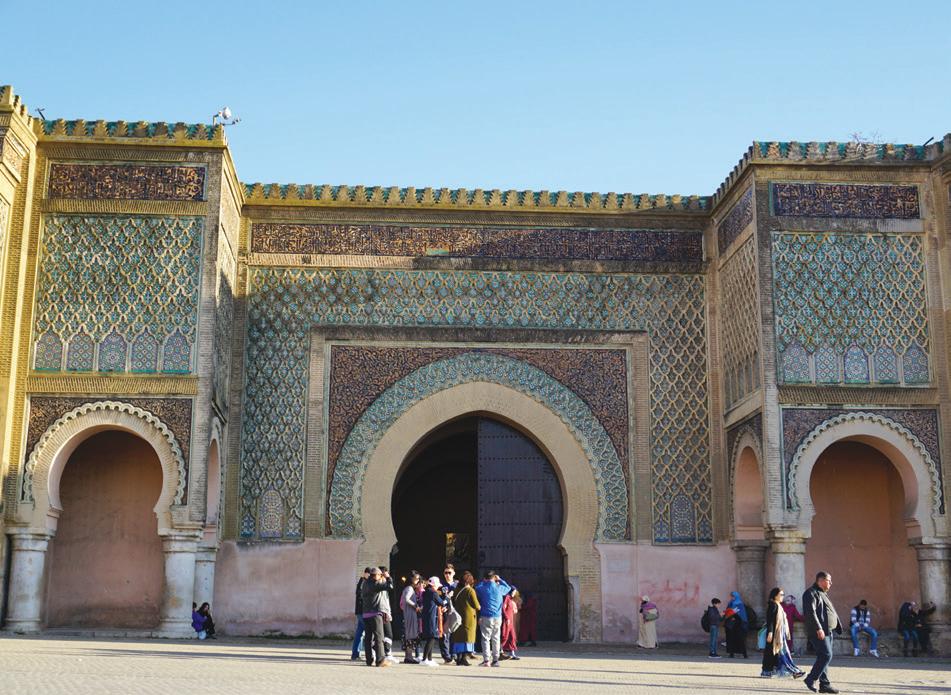
▼ The Bab Al-Mansour Laalaj the artistry of the mosque on its outside, as it is made up of 17 wings and 11 domes decorated with reliefs and its ornate minaret. The sultans announced through it many of their decisions, and the mosque witnessed many great events in history.
Meknes
Meknes, one of the most important tourist cities in Morocco, built by Moulay Ismail and located in the north, it is characterized by the diversity of its landscape, which includes plains, valleys, and mountains. Many tourists from all over the world visit Meknes to see its ancient places such as Lahdim Square, Bab Al-Mansour, and the Mausoleum of Moulay Ismail. The city of Meknes has a long history that tells of its ramparts, towers, and historic places, preserved in the city’s splendor and monuments. It is truly regarded as a city representative of Islamic Arab civilization and brilliant history.
Bab Mansour Laalaj is considered one of the most important monuments for tourism in Meknes. It is a huge gate that overlooks Lahdim Square to the east of the old town of Meknes. It is also the largest gate in the Kasbah. It was founded by Moulay Ismail and was completed after him by his son, Moulay Abd-Allah in 1732 A.D. What
▲ Volubilis, the Roman temple.

distinguishes this gate is the magnitude of its detail, its eight-meter-high opening, and its decorations engraved into the mosaic, which also includes colorful porcelain.
One of the most important tourist sites in Meknes is Volubilis, an ancient city dating from the 3rd century B.C. and located 30 kilometers west of the city of Meknes. The city has two structures: the main building and the Roman temple. It also has many archaeological mosaics. The city of Volubilis is characterized by its many natural features such as fertile land, water resources, and natural resources, all of which encouraged the Romans to take special care of it. In 1997, the city of Volubilis was designated by the United Nations Educational, Scientific, and Cultural
▲ Chefchaouen Bazar

Organization as one of the most important monuments of world heritage.
Chefchaouen: Th e Blue Pearl
Th e charming town of Chefchaouen is a small town with an area of 4,350 square kilometers in the northeast of Morocco and close to the Mediterranean, which makes it a picturesque town in terms of its nature and beauty. Th e city contains several old neighborhoods, such as the Kasbah, Suwaiqa, Andalus, and Sabanin. Chefchaouen is also famous for its fountain and its waterhead. Chefchaouen is also a popular shopping destination, as it off ers many local handicraft s that are not available anywhere else in Morocco, such as leather and natural silk.
▲ Chefchaouen Street
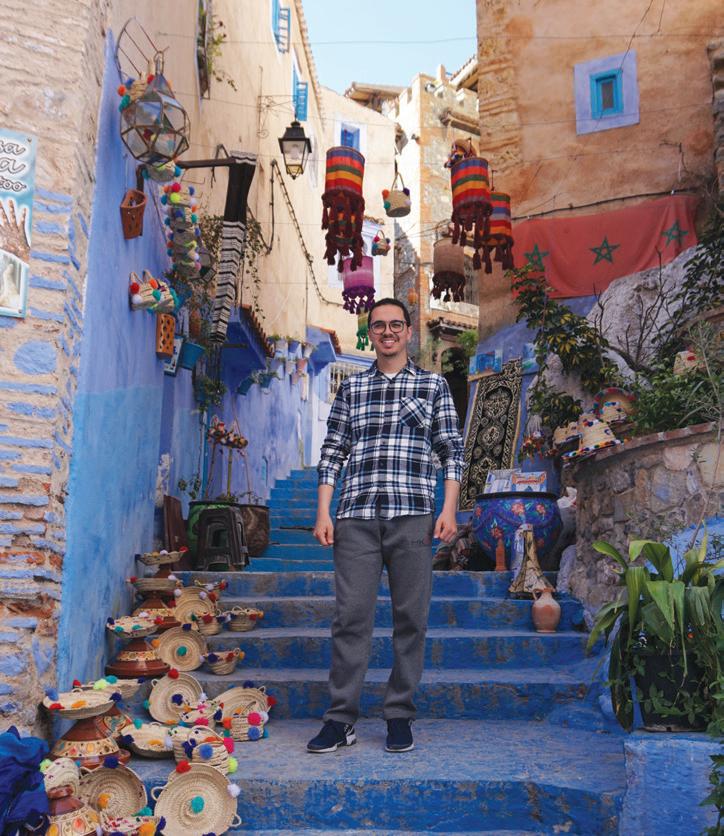
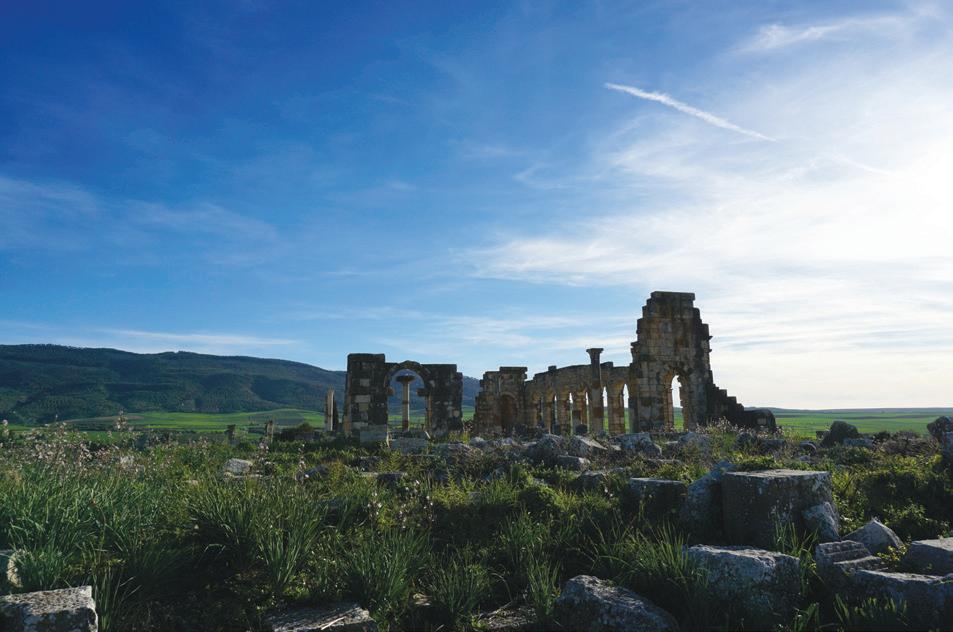
▼ Volubilis, the Roman temple.
Visiting Akchour Waterfall tops the list as the most amazing leisure activity destination in Chefchaouen Akchour, with a waterfall characterized by the beauty of its landscape, the purity of the water, and the splendor of swimming near the falls, whose water comes from the high mountains and pour into Lake Akchour.
Th ese cities are considered the most visited cities by foreigners and by locals alike, given the magnifi cent characteristics that they possess, and the historical civilizations that they refl ect.

Th e Mausoleum of Mohammed V
The Author
Farah Rida, a Moroccan student at Chonnam National University, is doing his PhD in English language education. Rida is passionate and hardworking, he loves traveling and playing video games.
